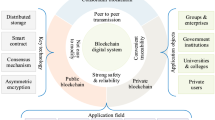Abstract
Blockchain is a recent technology whose importance is rapidly growing. One of its native features is pseudo-anonymity, since users are referred by (blockchain) addresses, which are hashed public keys with no link to real identities. However, when moving from the use of blockchain as simple platform for cryptocurrencies to applications in which we want to automatize trust and transparency, in general, there is not the need of anonymity. Indeed, there are situations in which secure accountability, trust and transparency should coexist (e.g., in supply-chain management) to accomplish the goal of the application to design. Blockchain may appear little suitable for these cases, due to its pseudo-anonymity feature, so that an important research problem is to understand how to overcome this drawback. In this paper, we address this problem by proposing a solution that mixes the mechanism of public digital identity with blockchain via Identity-Based-Encryption. We define the solution and show its application to a real-life case study.
Access this chapter
Tax calculation will be finalised at checkout
Purchases are for personal use only
Similar content being viewed by others
Notes
- 1.
For the sake of presentation and to avoid to introduce new notations, in the following, with a little abuse of notation, we use the address \(A_u\) also to refer to the user u, thus meaning “the user associated with the address \(A_u\)”.
References
ISO/IEC 24760–1:2011: Information technology – Security techniques – A framework for identity management – Part 1: Terminology and concepts (2011). http://standards.iso.org/ittf/PubliclyAvailableStandards/index.html
DHL crowd sources deliveries in Stockholm with MyWays (2013). http://www.dhl.com/en/press/releases/releases_2013/logistics/dhl_crowd_sources_deliveries_in_stockholm_with_myways.html
Base58Check (2018). https://en.bitcoin.it/wiki/Base58Check_encoding
Bitnation Pangea—Your Blockchain Jurisdiction (2018). https://tse.bitnation.co/
Digital identity (2018). https://en.wikipedia.org/wiki/Digital_identity/
Digital Identity and Service Accountability (2018). http://www.okt-srl.com/ricerca-pon-mise-idservice.html
eIDAS - Interoperability Architecture (2018). https://ec.europa.eu/futurium/en/content/eidas-regulation-regulation-eu-ndeg9102014
IBM Blockchain (2018). https://www.ibm.com/blockchain/solutions/identity
ID-based Encryption (2018). https://en.wikipedia.org/wiki/ID-based_encryption
OAuth Community Site (2018). https://oauth.net/
PiggyBee: CrowdShipping - Crowdsourced delivery (2018). https://www.piggybee.com/
QR code (2018). https://en.wikipedia.org/wiki/QR_code
RIPEMD (2018). https://en.wikipedia.org/wiki/RIPEMD
SHA-2 (2018). https://en.wikipedia.org/wiki/SHA-2
SPID Sistema Pubblico di Identità Digitale (2018). https://www.spid.gov.it/
Windows CardSpace (2018). https://en.wikipedia.org/wiki/Windows_CardSpace
Zipments: Same Day Delivery Service (2018). https://zipments.com/
Abeyratne, S.A., Monfared, R.P.: Blockchain ready manufacturing supply chain using distributed ledger (2016)
Angiulli, F., Fassetti, F., Furfaro, A., Piccolo, A., Saccà, D.: Achieving service accountability through blockchain and digital identity. In: Mendling, J., Mouratidis, H. (eds.) CAiSE 2018. LNBIP, vol. 317, pp. 16–23. Springer, Cham (2018). https://doi.org/10.1007/978-3-319-92901-9_2
Banerjee, A.: Blockchain technology: supply chain insights from ERP. Adv. Comput. 111, 69–98 (2018)
Biswas, K., Muthukkumarasamy, V.: Securing smart cities using blockchain technology. In: 2016 IEEE 18th International Conference on High Performance Computing and Communications, IEEE 14th International Conference on Smart City, IEEE 2nd International Conference on Data Science and Systems (HPCC/SmartCity/DSS), pp. 1392–1393. IEEE (2016)
Boneh, D., Franklin, M.: Identity-based encryption from the Weil pairing. In: Kilian, J. (ed.) CRYPTO 2001. LNCS, vol. 2139, pp. 213–229. Springer, Heidelberg (2001). https://doi.org/10.1007/3-540-44647-8_13
Buccafurri, F., Fotia, L., Lax, G.: Implementing advanced electronic signature by public digital identity system (SPID). In: Kő, A., Francesconi, E. (eds.) EGOVIS 2016. LNCS, vol. 9831, pp. 289–303. Springer, Cham (2016). https://doi.org/10.1007/978-3-319-44159-7_21
Buccafurri, F., Fotia, L., Lax, G., Mammoliti, R.: Enhancing public digital identity system (SPID) to prevent information leakage. In: Kő, A., Francesconi, E. (eds.) EGOVIS 2015. LNCS, vol. 9265, pp. 57–70. Springer, Cham (2015). https://doi.org/10.1007/978-3-319-22389-6_5
Christopher, M.: Logistics & Supply Chain Management. Pearson, London (2016)
Dayarian, I., Savelsbergh, M.: Crowdshipping and same-day delivery: employing in-store customers to deliver online orders. Optimization Online (2017)
Iansiti, M., Lakhani, K.R.: The truth about blockchain. Harv. Bus. Rev. 95(1), 118–127 (2017)
Jacobovitz, O.: Blockchain for identity management (2016)
Korpela, K., Hallikas, J., Dahlberg, T.: Digital supply chain transformation toward blockchain integration. In: Proceedings of the 50th Hawaii International Conference on System Sciences (2017)
Lewko, A., Waters, B.: Decentralizing attribute-based encryption. In: Paterson, K.G. (ed.) EUROCRYPT 2011. LNCS, vol. 6632, pp. 568–588. Springer, Heidelberg (2011). https://doi.org/10.1007/978-3-642-20465-4_31
Marcucci, E., Le Pira, M., Carrocci, C.S., Gatta, V., Pieralice, E.: Connected shared mobility for passengers and freight: investigating the potential of crowdshipping in urban areas. In: 2017 5th IEEE International Conference on Models and Technologies for Intelligent Transportation Systems (MT-ITS), pp. 839–843. IEEE (2017)
Mayer, H.: ECDSA security in bitcoin and ethereum: a research survey. CoinFaabrik, 28 June 2016
Moreno, F., Trivedi, S.: Staying Anonymous on the Blockchain: Concerns and Techniques (2017). https://securingtomorrow.mcafee.com/mcafee-labs/staying-anonymous-on-the-blockchain-concerns-and-techniques/
Nakamoto, S.: Bitcoin: a peer-to-peer electronic cash system (2008)
Rivest, R.L., Shamir, A., Adleman, L.: A method for obtaining digital signatures and public-key cryptosystems. Commun. ACM 21(2), 120–126 (1978)
Sakai, R., Kasahara, M.: ID based cryptosystems with pairing on elliptic curve. IACR Cryptology ePrint Archive, p. 54 (2003)
Tsakalakis, N., Stalla-Bourdillon, S., O’hara, K.: What’s in a name: the conflicting views of pseudonymisation under eIDAS and the general data protection regulation (2016)
Acknowledgment
This paper has been partially supported by the project “Id Service - Digital Identity and Service Accountability” funded by the Ministry of Economic Development (MISE), project code number F/050238/03/X32 and by INdAM – GNCS Project 2018 “Processing and analysis of Big Data modeled as graphs in different application contexts".
Author information
Authors and Affiliations
Corresponding author
Editor information
Editors and Affiliations
Rights and permissions
Copyright information
© 2018 Springer Nature Switzerland AG
About this paper
Cite this paper
Buccafurri, F., Lax, G., Russo, A., Zunino, G. (2018). Integrating Digital Identity and Blockchain. In: Panetto, H., Debruyne, C., Proper, H., Ardagna, C., Roman, D., Meersman, R. (eds) On the Move to Meaningful Internet Systems. OTM 2018 Conferences. OTM 2018. Lecture Notes in Computer Science(), vol 11229. Springer, Cham. https://doi.org/10.1007/978-3-030-02610-3_32
Download citation
DOI: https://doi.org/10.1007/978-3-030-02610-3_32
Published:
Publisher Name: Springer, Cham
Print ISBN: 978-3-030-02609-7
Online ISBN: 978-3-030-02610-3
eBook Packages: Computer ScienceComputer Science (R0)




